For the first time in 130 years, both legislative bodies in California and the state's executive branch will be fully controlled by one party. Democrats in the State Assembly and Senate now have the two-thirds majority needed to pass the budget they want, and raise taxes without a single Republican vote.
Getting to a Democratic supermajority has been a talking point within the party's leadership for years. Yet, it had always been just talk. Both parties have spent more time protecting incumbent seats than going after new seats.
The emerging Latino electorate has now spread into areas of the state that have been Republican strongholds in the past, such as the Central Valley and the Inland Empire. With Latinos registering and voting overwhelmingly Democratic, there is an emerging challenge to Republican candidates who have traditionally dominated these areas.
The Central Valley now has four Democratic Latino representatives in Sacramento: Rudy Salas (AD 32) of Bakersfield, Henry Parrea (AD 31) of Fresno, Luis Alejo (AD30) of Salinas, and Michael Rubio (SD16) of Stockton. Rubio joins Cathleen Galgiani (SD5) from Stockton as the second Central Valley Democrat in the Senate. With Steve Fox representing part of Kern County, there are now six Democrats in Sacramento representing at least parts of the Central Valley.
In Riverside, Manuel Perez won re-election in the redrawn Assembly District 56 while Jose Medina will join him from a former Republican stronghold, Assembly District 61. They will join fellow Democrat Richard Roth (SD31) to give Riverside County three Democrats in Sacramento.
In San Bernardino, Roth represents part of the county and is now joined by two African-American Democrats; Chris Holden (AD41) and Cheryl Brown (AD 41). Norma Torres (AD52) is the fourth Democrat representing San Bernardino County.
In North Orange County, Democrat Sharon Quirk-Silva picked up Assembly District 65 to become Orange County's third Democrat. Additionally, Steve Fox (AD36) now represents a large part of the historically conservative Antelope Valley.
Population growth has led to a surge of Latino voters in the Central Valley while the growing LA County exodus of African-Americans in the Inland Empire has partnered with the Latino vote to begin a shift in the political landscape in the area.
Former Republican Lt. Governor Abel Maldenado's advise to fellow Republicans to observe “birth and death announcements” seems prophetic following the 2012 elections. In fact, according to voter registration numbers, there are now over 1,000,000 Latino voters in the counties of San Bernardino, Riverside, Fresno, Kern, and Orange.
This trend will only continue as high school enrollment of Latinos has increased dramatically. According to the State Department of Education, Latino enrollment in public schools increased from 2001 to 2010 by 33% in San Bernardino, 21% in Fresno, 58% in Riverside, and 45% in Kern counties.
With over half of California newborns being Latino, Latino population majorities will continue to rise across the state. It is a trend that may alter the political landscape of California even further.
If Republicans cannot appeal to Latino voters, a Democratic supermajority in Sacramento may become the norm. Perhaps the biggest lesson learned from the 2012 elections is that the “Latino voting wave” is not only real, but is rising higher.

